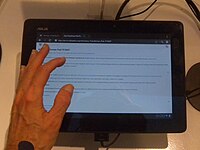
Asus Eee is a family of products by AsusTek Computer Inc. The product family began with the release of the Eee PC subnotebook in 2007; since then, the product family has diversified into a number of PC form factors. According to the company, the name Eee derives from "the three Es," an abbreviation of its advertising slogan for the device: "Easy to learn, Easy to work, Easy to play".

The Samsung Galaxy S is a touchscreen-enabled, slate-format Android smartphone designed, developed, and marketed by Samsung Electronics; it is the first smartphone of the Samsung Galaxy S series. It is the first device of the third Android smartphone series produced by Samsung. It was announced to the press in March 2010 and released for sale in June 2010. Due to shortage of Super AMOLED displays, Samsung released a successor to the device called S scLCD or SL and ceased production of the original I9000 model.
Google Nexus is a discontinued line of consumer electronic devices that run the Android operating system. Google managed the design, development, marketing, and support of these devices, but some development and all manufacturing were carried out by partnering with original equipment manufacturers (OEMs). Alongside the main smartphone products, the line also included tablet computers and streaming media players; the Nexus started out in January 2010 and reached its end in October 2016, replaced by Google Pixel.
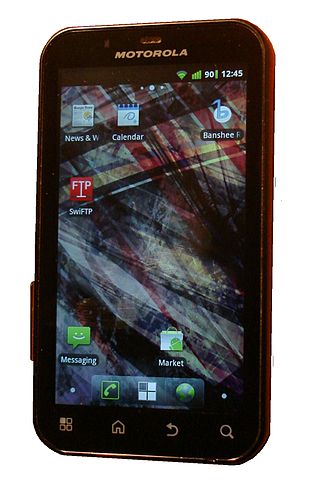
The Motorola Defy (A8210/MB525) is an Android-based smartphone from Motorola. It filled a niche market segment, by being one of the few small, IP67 rated smartphones available at the time of its late 2010 release; it is water resistant, dust resistant, and has an impact-resistant screen. An updated version of the original model, Defy+ (MB526) was released in 2011. Other variants were also released before a revival of the Defy name in 2021.
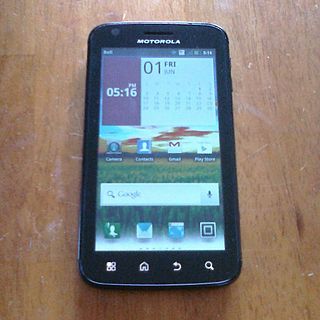
The Motorola Atrix 4G is an Android-based smartphone developed by Motorola, introduced at CES 2011 along with the Motorola Xoom, Motorola Droid Bionic, and Motorola Cliq 2 on January 5, 2011. It was made available in the first quarter of 2011.

The HP TouchPad is a tablet computer that was developed and designed by Hewlett-Packard. The HP TouchPad was launched on July 1, 2011, in the United States; July 15 in Canada, United Kingdom, France, Germany; and August 15 in Australia.

The Asus Eee Pad Transformer TF101 is a 2-in-1 detachable tablet developed by Asus that runs the Android operating system. It is the first tablet in the Asus Transformer Pad series. The Eee Pad Transformer features a 10.1-inch (260 mm) display, an Nvidia Tegra 2 dual-core chip, 1 GB of RAM, and 16 or 32 GB of storage. The tablet initially launched with Android 3.1, nicknamed "Honeycomb", but was updated to support Android 4.0.3.

The Acer Iconia A500 is a tablet computer designed, developed and marketed by Acer Inc. The A500 launched with the Android Honeycomb operating system which is now upgradable to Ice Cream Sandwich 4.0.3. The tablet is also sold in almost identical form as the Packard Bell Liberty Tab G100.

The Asus Eee Pad Transformer TF201 or Asus Eee Pad Transformer Prime is a 2-in-1 detachable tablet from the Asus Transformer Pad series. It is the world's first Android tablet computer with a quad-core processor, and a successor to the dual-core Asus Eee Pad Transformer. It runs Android 4.1. The Transformer Prime was announced by Asus on 9 November 2011. It was released in Taiwan on 1 December 2011, and in Canada and the United States during the week of 19 December 2011.
The IdeaPad tablets from Lenovo were a brand of consumer-oriented tablet computers designed for home use or entertainment, as opposed to the business-focused ThinkPad Tablet series. Devices sold in certain countries, such as China, India and New Zealand, were sold under the LePad brand, similar to the LePhone series of smartphones. IdeaPad-branded tablets have been produced with the Android and Windows operating systems.

Asus PadFone is a smartphone manufactured by Asus and released in April 2012. The phone is marketed with companion tablet dock and keyboard dock accessories intended to improve functionality and battery life. It fits into a 10-inch tablet dock. It is not the same as the Asus PadFone mini 4.3, revealed by Asus in December 2013 since that operates on Android 4.3 Jelly Bean and is skinned with the Asus' ZenUI.
Asus Transformer Pad TF700T or Asus Transformer Pad Infinity - is a tablet computer made by Asus, successor to the Asus Transformer Prime. The manufacturer announced it at CES 2012, less than a month after the original product launch, to launch Q2 2012.

VivoTab is a series of Microsoft Windows hybrid tablet computers designed by Asus. It is a sub-series of the Vivo series by Asus. The name is derived from the Latin word "to live" and, along with Asus's Transformer series of convertible devices running Windows, is a primary competitor to the Microsoft Surface.
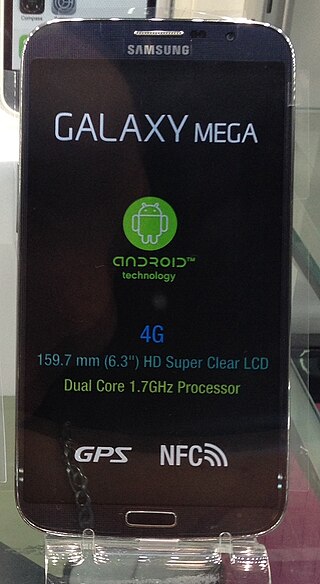
The Samsung Galaxy Mega is an Android-based phablet that was manufactured and released by Samsung. It was announced on April 11, 2013. The original model featured a 6.3 in (160 mm) screen, though a revised version was released with a 5.8 in (150 mm) screen. It has a 1,280×720 screen, a dual-core 1.7 GHz processor and an 8-megapixel camera. The phone runs Android 4.2.2 "Jelly Bean" software, and internal storage is 8 or 16 GB.

The second-generation Nexus 7, also commonly referred to as the Nexus 7 (2013), is a mini tablet computer co-developed by Google and Asus that runs the Android operating system. It is the second of three tablets in the Google Nexus tablet series, the Nexus family including both phones and tablets running essentially stock Android which were originally marketed for developer testing but later marketed by Google to consumers as well, all of which were built by various original equipment manufacturer partners. Following the success of the original Nexus 7, this second generation of the device was released on July 26, 2013, four days earlier than the originally scheduled date due to early releases from various retailers. The tablet was the first device to ship with Android 4.3.

Sony Xperia L (C2104/C2105) is a Sony's budget oriented smartphone manufactured by Sony, announced in March 2013 and launched in May 2013.

AOKP, short for Android Open Kang Project, is an open-source replacement distribution for smartphones and tablet computers based on the Android mobile operating system. The name is a play on the word kang and AOSP. The name was a joke, but it stuck. It was started as free and open-source software by Roman Birg based on the official releases of Android Open Source Project by Google, with added original and third-party code, features, and control.

OmniROM is an open-source operating system for smartphones and tablet computers, based on the Android mobile platform. It involves a number of prominent developers from other projects.
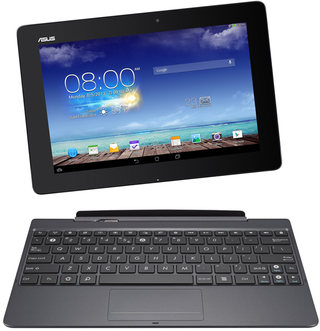
The Asus Transformer Pad TF701T is an Android tablet computer made by Asus, successor to the Asus Transformer Pad Infinity. The Transformer design includes a docking keyboard. The Asus Transformer Pad TF701T was released in the UK in October 2013 and in the U.S. in November 2013.
The Asus Transformer Pad TF103C is a 2-in-1 detachable tablet from the Asus Transformer Pad series.
